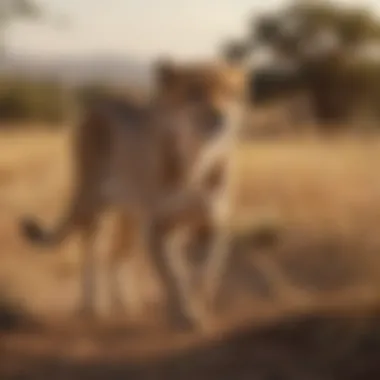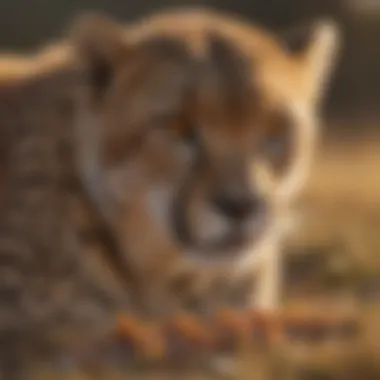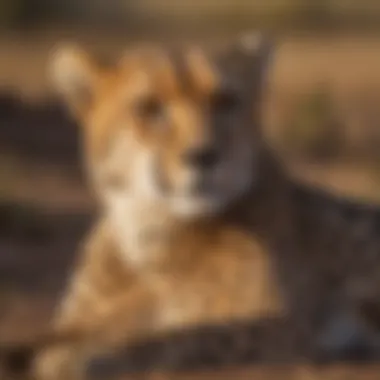Unveiling the Intriguing Feeding Patterns of Cheetahs


Animal Species Profile
Cheetahs, the fastest land animals on Earth, are a marvel to behold in the wild. With their sleek bodies, distinctive black tear stripes running from their eyes to their noses, and slender, powerful build, cheetahs are instantly recognizable. Their natural habitat primarily consists of savannas, grasslands, and dense scrubs across various regions in Africa and a small population in Iran. Known for their solitary nature, these incredible predators often exhibit remarkable social behaviors, particularly when raising their cubs.
Feeding Habits and Dietary Patterns
When it comes to feeding habits, cheetahs are opportunistic carnivores, prioritizing fresh meat in their diet. These agile hunters rely on bursts of speed up to 60-70 miles per hour to catch their prey, primarily targeting small to medium-sized ungulates such as gazelles and impalas. Unlike other big cats, cheetahs do not boast the same strength for taking down large prey but instead focus on quick chases to make a kill. Their keen eyesight spots potential meals from a distance, allowing them to approach stealthily before launching a rapid attack. After a successful hunt, cheetahs consume their prey immediately, minimizing the risk of losing their meal to stronger predators, like lions or hyenas, in the savanna landscape.
Hunting Strategies and Techniques
Cheetahs rely on exceptional speed and agility when hunting, preferring to sprint short distances to catch their prey rather than engaging in prolonged pursuits. Their slender build, flexible spine, and non-retractable claws contribute to their success in hunting, aiding in quick turns and sharp directional changes during a chase. Before initiating a hunt, cheetahs meticulously observe the surrounding terrain to plan their strategy, often utilizing the element of surprise to gain the upper hand. While their acceleration and top speed are remarkable assets, cheetahs must choose their targets wisely, conserving energy for successful pursuits and avoiding unnecessary risks on the challenging African plains.
Role of Feeding Behavior in Survival
Understanding the intricate feeding behavior of cheetahs is crucial to appreciating their survival strategies in the wild. By dissecting their dietary patterns, hunting efficiency, and instinctual behaviors, one gains insight into the delicate balance between predator and prey in the African ecosystem. Cheetahs' adaptation of specific feeding habits, tailored to their physical abilities and environmental factors, underscores their evolutionary mastery as specialized hunters in a competitive landscape. Studying their feeding behavior not only reveals the complexities of their biological needs but also sheds light on the interconnection between species and the impact of human intervention on wildlife conservation efforts.
Introduction to Cheetahs
As we embark on this journey to delve into the intricate world of cheetahs, it is essential to grasp the fundamental aspects that define these remarkable creatures. Cheetahs, characterized by their unique physical features and fascinating behavioral patterns, hold a prominent place in the ecosystem. Understanding the nuances of cheetah behavior provides valuable insights into the dynamics of wildlife and fosters a profound appreciation for these majestic felines. Exploring the basic overview of cheetahs offers a glimpse into their evolutionary adaptations and survival strategies, shedding light on their significance in the animal kingdom.
Basic Overview of Cheetahs
Physical Characteristics
One of the most striking aspects of cheetahs is their unparalleled agility and speed, making them the fastest land mammals on Earth. Their slender build, distinctive black tear marks on the face, and camouflaged fur set them apart in the savannas of Africa. The aerodynamic design of their body, with elongated limbs and a deep chest, enables swift movements essential for hunting and evading predators. While their speed is a remarkable trait, it comes with the trade-off of reduced endurance, requiring strategic hunting techniques.
Habitat and Range
Cheetahs primarily inhabit open grasslands, savannas, and semi-arid regions where they can spot prey from a distance and engage in high-speed pursuits. Their distribution across sub-Saharan Africa and parts of Iran reflects their adaptive nature to varied landscapes. The unique habitat preferences of cheetahs influence their hunting strategies, social interactions, and overall survival in competitive environments. However, habitat loss and human encroachment threaten these ecosystems, impacting cheetah populations worldwide.
Social Structure


Unlike other big cats, cheetahs exhibit a solitary lifestyle, with males forming coalitions for defending territories and increasing hunting success. Female cheetahs raise their cubs independently, teaching them vital hunting skills before they venture out on their own. The absence of a complex social hierarchy contributes to the independence and self-reliance seen in these phenomenal hunters. Understanding the dynamics of cheetah social structures unveils the intricate balance between cooperation and individualism in their quest for survival.
Unique Features of Cheetahs
Speed and Agility
The exceptional speed and agility displayed by cheetahs play a pivotal role in their hunting prowess. Their ability to reach speeds of up to 60-70 miles per hour in mere seconds enables efficient pursuit and takedown of prey. The flexible spine, enlarged nostrils for increased oxygen intake, and specialized muscles for rapid acceleration distinguish cheetahs as formidable predators in the wild. Despite their remarkable burst of speed, cheetahs rely on short, intense sprints to overpower agile prey, showcasing the dynamic nature of their hunting tactics.
Hunting Techniques
Cheetahs deploy a unique blend of stealth and speed when hunting, utilizing concealment in tall grasses to approach unsuspecting prey before initiating a lightning-fast chase. Their keen eyesight and binocular vision aid in target identification, allowing for precise movements during the pursuit. The coordinated effort between chase initiation, sprinting bursts, and suffocation techniques distinguishes cheetahs as specialized hunters with a high success rate in capturing elusive prey. By dissecting the intricate hunting techniques of cheetahs, we gain a profound understanding of their evolutionary adaptations and survival strategies in the unforgiving wild.
Cheetah Diet and Feeding Behavior
Primary Diet of Cheetahs
Cheetahs exhibit a distinctive preference for certain prey species, optimizing their hunting success and nutritional intake. Their prey preference often revolves around targeting swift ungulates such as gazelles and impalas, showcasing the cheetah's preference for agile animals that provide both a challenging chase and a substantial meal. This preference aligns with the cheetah's need for high energy intake from lean meat, highlighting its adaptation to a specialized diet that caters to its unique physiological requirements.
Nutritional Requirements
The nutritional requirements of cheetahs go beyond mere sustenance; they dictate the feline's health, performance, and overall well-being. From the need for high protein content to support muscle mass and agility to the essential vitamins and minerals vital for metabolic functions, cheetahs have finely tuned nutritional demands that must be met through their prey selection. Understanding these requirements sheds light on the meticulous balance cheetahs maintain in their diet, ensuring they remain at the pinnacle of their physical capabilities.
Frequency of Cheetah Meals
The frequency of cheetah meals plays a crucial role in dictating their hunting patterns, energy levels, and overall survival strategies in the wilderness. The daily feeding patterns of cheetahs often revolve around optimizing their energy expenditure, with calculated meal timings that coincide with periods of heightened prey activity. By examining these feeding patterns, one can unravel the strategic calculations cheetahs employ to maximize their hunting efficiency and minimize potential risks associated with securing their next meal.
Factors Influencing Feeding Frequency
Various intrinsic and extrinsic factors influence the feeding frequency of cheetahs, shaping their dietary habits and hunting behaviors in complex ways. From environmental conditions impacting prey abundance to competition with other predators for food resources, cheetahs navigate a dynamic landscape where feeding frequency is not merely a matter of hunger but a strategic adaptation to ensure survival. Recognizing these influences offers a window into the intricate web of interactions that govern the feeding ecology of cheetahs.
Hunting and Consumption
The hunting strategies adopted by cheetahs embody a delicate balance between stealth, speed, and precision, culminating in the efficient procurement of their prey. Stalking and ambush strategies form the core of cheetah hunting techniques, allowing them to capitalize on their sprinting abilities and sharp reflexes to secure a successful kill. Similarly, the eating habits of cheetahs reflect their evolutionary prowess, showcasing efficient consumption patterns that optimize nutrient intake while minimizing potential wastage, a testament to their streamlined approach to survival in the wild.
Adaptations for Efficient Feeding
Adaptations for efficient feeding play a crucial role in the survival and success of cheetahs in the wild. These adaptations encompass both physiological and behavioral aspects that enable cheetahs to optimize their feeding strategies for maximum energy gain and survival. By honing in on specific elements such as their digestive system and metabolic rate, cheetahs have evolved to excel in their role as predators, securing their place as one of the most skilled hunters in the animal kingdom.
Physiological Adaptations
Digestive System
The digestive system of cheetahs is a marvel of biological evolution, finely tuned to efficiently process their primary diet of freshly caught prey. With a specialized structure designed for rapid digestion and absorption of nutrients, the cheetah's digestive system allows for quick energy replenishment after a hunt. This unique feature of their digestive system contributes significantly to their ability to sustain high-intensity bursts of activity, essential for capturing swift prey in their habitat. Despite some minor drawbacks in terms of processing certain types of food, the cheetah's digestive system remains a critical component of their adaptation for efficient feeding.
Metabolic Rate
The metabolic rate of cheetahs is a key factor in their adaptations for efficient feeding. With a metabolism tailored for swift energy production and utilization, cheetahs can maintain their agility and speed during hunts. Their high metabolic rate facilitates rapid energy release, supporting their bursts of intense activity during chases. This unique feature enables cheetahs to efficiently convert the nutrients from their diet into usable energy, essential for sustaining their predatory lifestyle. While there are some trade-offs in terms of energy conservation during rest periods, the benefits of their high metabolic rate far outweigh any disadvantages, making it a crucial element in their feeding adaptations.
Behavioral Adaptations
Sole Predator Behavior
The behavior of cheetahs as solitary predators is a key aspect of their feeding adaptations. By hunting alone, cheetahs minimize competition for food and maximize their chances of successful hunts. This solitary behavior allows them to focus on hunting without the distraction of group dynamics, increasing their efficiency as predators. The unique feature of their solitary hunting behavior lies in their ability to strategize and execute hunts independently, showcasing their exceptional skills as apex predators. While there may be risks associated with hunting alone, such as vulnerability to larger predators, the advantage of being the sole predator during a hunt far outweighs the potential drawbacks.
Competition Avoidance
Competition avoidance is another behavioral adaptation that contributes significantly to the feeding success of cheetahs. By actively avoiding confrontations with other predators such as lions or hyenas, cheetahs reduce the risk of losing their kills and ensure their access to fresh prey. This key characteristic of competition avoidance allows cheetahs to secure their hunting grounds and minimize potential threats to their survival. The unique feature of their avoidance behavior lies in their ability to assess risk and strategically navigate their environment to steer clear of competing predators. While there may be instances where competition avoidance restricts their access to certain territories, the overall benefit of maintaining a low-risk feeding environment far exceeds any limitations it may pose.
Human Impacts on Cheetah Feeding Patterns
As we delve into the intricate ecosystem of cheetah feeding habits, it is imperative to comprehend the significant role that human impacts play in influencing these majestic creatures' feeding patterns. Human activities such as habitat loss, fragmentation, poaching, and illegal trade have a profound impact on the ability of cheetahs to hunt and procure adequate sustenance. By examining how human actions disrupt the delicate balance of the cheetah's natural environment, we can appreciate the intricate link between human presence and the feeding behavior of these agile predators.
Habitat Loss and Fragmentation
Disruption of Prey Populations


Within the context of cheetah feeding patterns, the disruption of prey populations stands out as a pivotal factor contributing to the overall challenges faced by these feline hunters. The relentless encroachment of human developments into cheetah habitats not only diminishes the availability of prey species but also disrupts their natural distribution patterns. This disruption cascades through the ecosystem, influencing the dynamics of predator-prey relationships and ultimately impinging on the cheetah's ability to sustain itself efficiently.
Conflict with Humans
Another critical facet of human impact on cheetah feeding behavior is the unavoidable conflict that arises between these wild predators and human populations. As cheetahs' natural habitats shrink due to human expansion, encounters between cheetahs and humans become more frequent, leading to conflicts that often result in detrimental consequences for both parties. Understanding the root causes of these conflicts and implementing effective mitigation strategies is essential for preserving both cheetah populations and human livelihoods in shared landscapes.
Poaching and Illegal Trade
Impact on Cheetah Predation
The illicit practices of poaching and illegal trade have a profound impact on cheetah predation patterns, disrupting the intricate balance of prey availability in their ecosystems. Cheetahs, already facing challenges due to habitat loss and human conflicts, are further endangered by the targeted hunting of their natural prey species for commercial gain. This detrimental practice not only diminishes the cheetah's food sources but also jeopardizes the delicate equilibrium of biodiversity in regions where these graceful hunters roam.
Loss of Natural Prey
The loss of natural prey presents a pressing concern in the realm of cheetah feeding habits, directly stemming from human activities such as overhunting and habitat destruction. As key prey species decline in numbers due to anthropogenic factors, cheetahs are compelled to adapt their hunting strategies and may resort to targeting livestock or venturing into human-dominated areas in search of sustenance. This shift not only places additional strain on already vulnerable cheetah populations but also exacerbates the conflicts between wildlife conservation and human interests.
Conservation Efforts and Future Prospects
In delving deeper into the realm of cheetah feeding habits, it becomes imperative to shed light on the crucial aspect of Conservation Efforts and Future Prospects. The preservation of cheetahs and their natural habitats is paramount for the continuity of this magnificent species. By understanding the challenges they face and the measures being taken, we pave the way for a future where these majestic animals can thrive.
Conservation Initiatives
Protected Areas
Exploring the genesis of Protected Areas unveils a sanctuary designed to shield cheetahs from various threats. These designated territories serve as safe havens, preserving biodiversity and providing undisturbed habitats crucial for the survival of cheetahs. The intricate balance maintained within Protected Areas ensures the harmony of ecosystems, safeguarding these agile predators from rampant encroachments.
Anti-Poaching Programs
Embarking on a journey through Anti-Poaching Programs unveils a shield erected against the nefarious acts threatening cheetah populations. These proactive strategies aim to curb illegal activities that jeopardize the existence of cheetahs. By strengthening surveillance and instilling awareness, Anti-Poaching Programs fortify the bulwark defending cheetahs from ruthless exploitation.
Challenges and Opportunities
Balancing Human Needs and Wildlife Protection
Diving into the delicate equilibrium between Human Needs and Wildlife Protection unveils a complex interplay crucial for sustainable coexistence. As human populations expand, the challenge lies in mitigating conflicts while ensuring the preservation of these magnificent creatures. Striking a balance demands innovative solutions that prioritize both human welfare and wildlife conservation, fostering a harmonious relationship within shared landscapes.
Future Research Directions
Venturing into the realm of Future Research Directions sheds light on the uncharted territories awaiting exploration. The beckoning horizons of scientific inquiry present vast opportunities to unravel mysteries and enhance conservation strategies. By investing in cutting-edge research, we open new vistas of understanding, propelling conservation efforts forward into uncharted realms of discovery and preservation.







